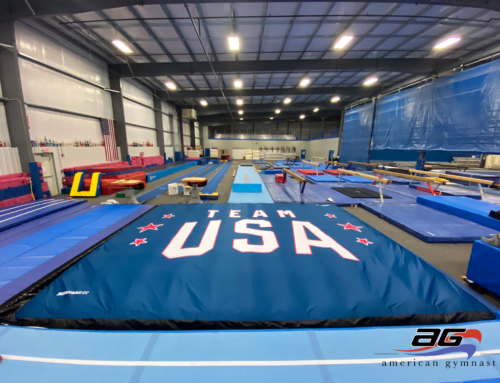“Don’t Forget About Floor.”
That was the advice of a couple of our wise readers, Louise and Brynn, after reading my post about my three possible U.S. women’s Olympic teams. And I have to admit, it’s an excellent point.
Strangely, often times we do tend to forget about floor – at least a little bit – when we put together our Olympic team scenarios. I think there are probably several reasons why we tend to do this. First, women’s floor scores tend to be the most unpredictable and hardest to understand of all four events and thus we feel a little less adept at putting together the best 3-gymnast lineup than we do on the other events. Second, we tend to assume that most of the top American gymnasts who compete floor are pretty good tumblers, and since floor is typically viewed as perhaps the most “stable” event, the gymnasts feel more “interchangeable” here. Finally, we don’t have as many obvious reasons to focus on floor as we do the other events – bars is widely considered the team’s weakness, beam is always going to be one of the critical events given the pressure of team finals, and on vault we know we need good Amanars. Floor is a little less clear. But if we do a little bit of research, we’d realize it would be foolish to ignore this event.
Floor has actually been the undoing of the American women more times than Martha Karolyi would care to remember. The Americans, who are accustomed to some of the bounciest floors in the world here in the U.S., are known for tumbling in the rafters in national competitions and then having trouble on some of the Asian and European floors, which often are harder and have a different texture that interferes with some of the turning dance elements. In 2000, several of the typically spectacular American routines (Elise Ray, Kristen Maloney, Jamie Dantzscher) suddenly looked much less so on the relatively hard floor in Sydney. In 2004, Courtney Kupets made some costly mistakes on some dance elements, and Mohini Bhardwaj wasn’t flying quite as high as she had at the Olympic Trials. In 2008, Alicia Sacramone looked nothing like the world floor champion she once had been, and in the team finals sat down her Arabian double front – a skill she normally dropped out of with ease. At the 2010 worlds, Mattie Larson’s unforgettable masterpiece from the U.S. Nationals just a few weeks prior suddenly turned into a nightmare on the unforgiving floor in Rotterdam.
Because of the seeding order from preliminaries in which the top two teams will end on floor in the team finals, the U.S. is likely to end its quest for Olympic gold in London on this event, just as it did in Athens, Beijing, and almost every world championships in the last decade (except Rotterdam 2010, where the U.S. was third in preliminaries). Let’s not be fools this time around – this team NEEDS three fantastic floor workers.
Most would be in agreement that Jordyn Wieber and Aly Raisman will take two of the three floor spots for team finals…so who will the third one be? My current projected teams all assume that either McKayla Maroney, Kyla Ross, or Gabby Douglas will compete in the third spot on this event. But is this ideal? It might not be.
McKayla Maroney did a fine job on this event in the world team finals last year, where she led the team off with a very solid 14.566. But Maroney hasn’t shown that yet this year…and besides, Romania will easily be capable of putting up 15’s across the board in London. Kyla Ross is a very stable floor worker, but she lacks difficulty, and typically scores low 14’s at best here with a hit set…and sometimes even less than that. And Gabby Douglas, though capable of a big score (scored 14.85 at the U.S. Classic with a 0.1 out of bounds deduction), can be a little unpredictable and out of control on her landings at times. One would have to wonder if the adrenaline boost in the final rotation of the Olympic team finals would be enough to send Gabby sailing out of bounds as we’ve seen her do before. After all, they don’t call her the flying squirrel for nothing.
Should the U.S. look for a third 15 on floor? It’s certainly not a bad idea, as long as it works out with covering the other three events. Sarah Finnegan, whom I currently project as an alternate, put up a huge 15.2 on floor at the U.S. Classic this wekeend, and she may well be the only other gymnast besides Wieber, Raisman, and occasionally Douglas who is truly capable of putting up a 15 on this event right now. Sabrina Vega, who, like Douglas, put up a very strong 14.85 on floor at the U.S. Classic, can obviously come pretty darn close to a 15 as well. Could Bridget Sloan be as strong on floor as she once was? It’s hard to predict until we see her on floor next week, but suffice it to say that paying attention to the top three floor scores at nationals and Trials will be extremely important. It’s an event where someone like Sarah Finnegan could sneak in and steal an Olympic spot if she keeps putting up 15’s here. Also note that Finnegan is one of the best beam workers in the mix as well, and could be a consideration for the third spot on this event. What’s even more interesting is that Finnegan is rumored to have an Amanar on vault, although we have yet to see it. If she is able to land them well at the four upcoming competitions, could she steal Maroney’s spot?
As you can see, there are a whole lot of questions still to be answered. Thanks, Louise and Brynn, for drawing our attention to this event which is often neglected compared to the others in this selection process, but ironically is where the final battle for the Olympic team gold will likely take place.



That’s what I said on your last post too!
Yes, you sure did – I added you in there to the post. Sorry about that! I looked back to see who that was that said that and came across Brynn’s post and assumed it was her, but actually, you both commented on this same point. Thanks for the great comments!
Andy
That was really obnoxious of me to post that in retrospect!! But thank you for your comment and adding me to your post. I appreciate your analysis and your blog!
I appreciate your analysis and your blog!
No worries – your voice should be heard!
This might be a weird point– but, I wonder of Gabby’s music was changed to something slower and easier to keep a beat with, and her dance was choreographed to be less spastic, she would improve her control on the event?? The music she has now is pretty wild, and it probably doesn’t help her control herself. A music/choreography change might do the trick… Just a thought. But maybe it’s because I’ve been wanting her to change the music and choreography to something world-class…
i’ve always hated her floor music/routine! it is very spastic and wild, just like her tumbling. i completely agree that if she was using a calmer and slower floor music that it would probably help her to slow down and focus on controlling her landings and tumbling. too bad that it might be too late to change it as visas and trials are so soon
Thanks for addressing this! I too agree that floor is often overlooked, but an event where the US can be outscored by Russia, Romania, and China. I think the US tends to sacrifice floor workers for other events, namely bars, that I feel are more unpredictable. Kytra Hunter is excellent on this event, but was never given any significant international opportunities.